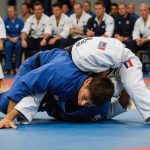Understanding Breakfall Techniques
Breakfall techniques hold a pivotal role in judo training due to their importance in athlete safety. These skills not only protect athletes from injury but also enhance overall performance. Learning how to fall correctly is fundamental to judo, ensuring that practitioners dissipate impact forces efficiently.
Among the various breakfall techniques employed in the UK, the most common are back breakfalls, side breakfalls, and forward rolling breakfalls. Each technique serves a distinct purpose, enabling athletes to safely manage impacts from different directions or falls.
In the same genre : Empowering uk judo athletes: proven tactical approaches for match preparation success
- Back breakfall: Softens the impact on the spine and tailbone.
- Side breakfall: Protects the shoulder and arm.
- Forward rolling breakfall: Allows momentum continuation, reducing injury potential.
Historically, breakfall training has evolved alongside judo’s progression. Initially, limited to basic fall techniques, over time, training has advanced with established standards focusing on precise execution and adaptability. Modern judo emphasizes dynamic and varied breakfalls, adapting to diverse situations encountered during practice and competition. Coaches instil these techniques early, promoting confidence and competence in their students.
Thus, mastering breakfall techniques is a crucial aspect of judo training, integral to both safety and competitive success.
Also to see : Maximizing athletic excellence: enhancing joint mobility for combat sports competitors in the uk
Key Strategies for Coaching Breakfalls
Successful judo coaching requires a blend of coaching strategies to promote effective skill development. Communication and the creation of a secure training environment are vital. Recognising unique athlete needs is also paramount.
Effective Communication in Coaching
Coaching strategies should include using both verbal and non-verbal cues adeptly. This ensures athletes comprehend instructions clearly and adjust their techniques accordingly. Verbal communication, such as concise explanations and encouragement, builds understanding. Non-verbal cues, such as demonstrations and gestures, reinforce learning and clarify techniques. Practising empathy and maintaining open dialogues further enhances rapport, fostering an athlete’s willingness to learn.
Establishing a Safe Learning Environment
A positive environment is indispensable for judo. Coaching strategies should prioritise safety and support, enabling athletes to practice without fear of injury. This involves clear communication regarding safety protocols and demonstrating correct techniques. Offering constructive feedback and acknowledging effort encourages skill development and confidence. Proper mat arrangement and supervision during practice also ensure a secure setting.
Tailoring Drills to Individual Athlete Needs
Effective judo coaching requires adapting drills based on athlete capability. Catering to these needs enhances performance and motivation. By observing strengths and weaknesses, coaches can modify exercises to match each athlete’s skill level. Providing varied drills helps in honing different aspects of breakfalls, promoting comprehensive skill enhancement.
Practical Drills for Breakfall Mastery
Embarking on a journey to master breakfall drills is an essential part of practical training for any martial arts enthusiast. These judo drills form the backbone of safety and efficiency in martial arts.
Step-by-step Breakdown of Effective Breakfall Drills
To begin with, practical training involves breaking down each movement step-by-step. Start by practising the basics, such as simple backward rolls, ensuring that each part of the body absorbs impact correctly. Focus on key concepts like tucking the chin, exhaling upon impact, and rolling through the spine.
Partner Work for Realistic Training Scenarios
Incorporating partner work into your routine can significantly enhance your breakfall skills. This involves practising throws and falls with a partner, allowing for feedback and adjustments in real-time. Working with a partner can simulate more realistic scenarios, thereby preparing you aptly for actual judo practice or competitions.
Progressing from Basic to Advanced Judo Drills
As you gain confidence, progressively shift toward more complex judo drills. These could include incorporating breakfalls into throws and sequences that mimic real-world situations. Transition from basic drills to advanced variations by gradually increasing speed and intensity, ensuring skill improvement.
This approach ensures a well-rounded development, equipping you with the resilience and technique needed for effective breakfalls.
Injury Prevention and Safety Measures
In the realm of judo, ensuring safety is paramount. Injury prevention can significantly enhance an athlete’s career longevity and performance. Let’s delve into effective risk management strategies.
Physiological Considerations for Athletes
Athletes must consider their body’s physiological responses to training. Ensuring balanced nutrition, adequate rest, and appropriate training workloads helps mitigate risks. Understanding body mechanics—especially during breakfalls—can aid in reducing injury occurrence.
Implementing Warm-Up and Cool-Down Routines
Adopting thorough warm-up and cool-down routines minimizes injury risk. Warm-ups increase heart rate and muscle temperature, preparing the body for exertion. Conversely, cool-downs help return the body to a resting state, preventing muscle stiffness.
Educating Athletes on Risk Awareness
Education is vital in promoting safety in judo. Teaching athletes the importance of flexibility and strength training fosters safer practice environments. Adequate instruction on body mechanics can enhance breakfall techniques, reducing impact-related injuries.
- Promote body mechanics understanding
- Develop a culture of therapeutic movements
- Emphasize strength and flexibility routines
Creating a culture of safety awareness is crucial among athletes. Continuous education sessions can reinforce the importance of injury prevention. Encouraging discussions about safety and providing feedback loops can significantly contribute to a safer sporting environment.
Case Studies: Successful Breakfall Implementation
Delving into case studies of judo programs reveals the transformative power of prioritising breakfall training. Programs that spotlight this fundamental skill see significant athlete improvement, boosting both confidence and performance. In several countries, judo clubs have embraced this approach, integrating breakfall techniques into their regimen from the onset.
One exemplar program at a London-based judo club highlights the role of breakfall training in reducing injuries and accelerating athlete improvement. Coaches at the club have witnessed firsthand the benefits, noting that athletes with strong breakfall skills demonstrate increased resilience and fewer training interruptions due to injury. This cultivation of safety and technique enables athletes to engage more fully in practice, unlocking their potential.
Testimonials from judo coaches echo similar sentiments. One coach shared, “The confidence my athletes gain from mastering breakfalls is unparalleled. It sets a foundation for success in all aspects of their judo journey.” Athletes also report feeling more secure and daring in their movements, directly attributing these benefits to consistent breakfall practice.
Overcoming challenges in implementing these programs often involves strategic planning and coaching success. By embedding breakfall training early and consistently, judo clubs ensure a smoother implementation that invariably pays off in performance.
Overcoming Coaching Challenges in Breakfall Training
Navigating coaching challenges in breakfall training requires understanding, patience, and innovative approaches. One of the most common issues faced is athlete resistance, which often stems from fear, lack of perceived risk, or simply not understanding the importance of breakfalls. To address this reluctance, it is crucial to communicate the practical benefits of breakfalls clearly, making the necessity and safety aspect well understood.
Addressing Common Athlete Resistance
Confronting athlete reluctance can be daunting but is vital for effective training. Engage athletes by discussing real-life scenarios where breakfalls prevent injuries, thus reinforcing their importance. Offering step-by-step demonstrations and gradually increasing difficulty can help ease fear.
Strategies for Maintaining Athlete Motivation
To enhance athlete engagement, trainers should employ creative strategies. Rotate exercises to avoid monotony, incorporate games, or introduce friendly competitions. Ensure that athletes set personal goals and celebrate small victories to uphold motivation.
Continual Assessment and Adaptation of Techniques
In the spirit of continuous improvement, continually assess and adapt training techniques. Feedback loops are vital; encourage athletes to voice their concerns and suggestions. Regularly review and tweak techniques to suit individual needs better, promoting both skill improvement and increased dedication from athletes.











